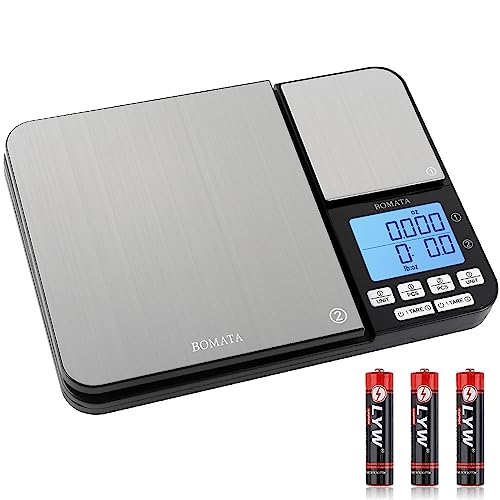- Joined
- Nov 6, 2010
- Messages
- 6,117
- Reaction score
- 5,420
For your oils, you can either weigh out two separate batches, or weigh out one batch of 27 ounces and then split off 9 ounces and 18 ounces into separate bowls. I prefer to measure out one batch of oils, then split it.
Do your oils whichever way and then set the bowls on the counter separated from each other, so you don't end up with confusion.
----------------------------------------------------------------------------
I think, in the long run, it's much easier to do the lye waters separately. Your entire batch needs 107 grams of lye but your scale goes to just one gram and not halves, so I would take the liberty of increasing your SF very slightly and going with 105 grams of lye. We are splitting it into 2/3 and 1/3 so that will be 70 grams for one and 35 grams for the other.
You want more translucency, which would be the high water, so that will be calculated for the 70 gm of lye.
----------------------------------------------------------------------------
So for the high water part, the ratio of water to lye is 2.4:1. We need 168 gms of water and 70 grams of lye. I got this number because we need 2.4 times as much water as we have lye and 2.4 x 70 = 168.
168:70 is equal to 2.4:1. Some people like to work in the percentage of lye to water and this is 29%, for anyone following who wants to stick that number in a soap calculator.
----------------------------------------------------------------------------
For the low water part, the ratio of water to lye is 1.4:1. We need 49 grams of water and 35 grams of lye. I got this number because we need 1.4 times as much water as we have lye and 1.4 x 35 = 49.
49:35 is equal to 1.4:1. For the percentage, this comes out to 41.6% so you can put 41% or 42% in a lye calculator.
-----------------------------------------------------------------------------
Put the bigger amount of lye water by the larger amount of oils and the smaller amount of lye water by the bowl with less oil. Sounds obvious but it's easy to get confused with multiples. It never hurts to label things.
Make sure you are using a very well-behaving FO or EO. I always make the low water batch (the smaller of the two in this case) first because it can take more time to get it to light trace. Once I'm there, I do the high water batch because it's easier to SB to about the same place as the low water in a shorter amount of time. Make sure you account for splitting and coloring of course.
So high water combo will be 18 ounces of oils with 238 gms total of lye water.
Low water combo will be 9 ounces of oils with 84 gms total of lye water.
If I lost you somewhere, let me know and I'll try to clarify.
Do your oils whichever way and then set the bowls on the counter separated from each other, so you don't end up with confusion.
----------------------------------------------------------------------------
I think, in the long run, it's much easier to do the lye waters separately. Your entire batch needs 107 grams of lye but your scale goes to just one gram and not halves, so I would take the liberty of increasing your SF very slightly and going with 105 grams of lye. We are splitting it into 2/3 and 1/3 so that will be 70 grams for one and 35 grams for the other.
You want more translucency, which would be the high water, so that will be calculated for the 70 gm of lye.
----------------------------------------------------------------------------
So for the high water part, the ratio of water to lye is 2.4:1. We need 168 gms of water and 70 grams of lye. I got this number because we need 2.4 times as much water as we have lye and 2.4 x 70 = 168.
168:70 is equal to 2.4:1. Some people like to work in the percentage of lye to water and this is 29%, for anyone following who wants to stick that number in a soap calculator.
----------------------------------------------------------------------------
For the low water part, the ratio of water to lye is 1.4:1. We need 49 grams of water and 35 grams of lye. I got this number because we need 1.4 times as much water as we have lye and 1.4 x 35 = 49.
49:35 is equal to 1.4:1. For the percentage, this comes out to 41.6% so you can put 41% or 42% in a lye calculator.
-----------------------------------------------------------------------------
Put the bigger amount of lye water by the larger amount of oils and the smaller amount of lye water by the bowl with less oil. Sounds obvious but it's easy to get confused with multiples. It never hurts to label things.
Make sure you are using a very well-behaving FO or EO. I always make the low water batch (the smaller of the two in this case) first because it can take more time to get it to light trace. Once I'm there, I do the high water batch because it's easier to SB to about the same place as the low water in a shorter amount of time. Make sure you account for splitting and coloring of course.
So high water combo will be 18 ounces of oils with 238 gms total of lye water.
Low water combo will be 9 ounces of oils with 84 gms total of lye water.
If I lost you somewhere, let me know and I'll try to clarify.
Last edited:















































